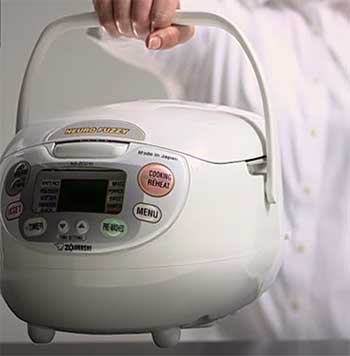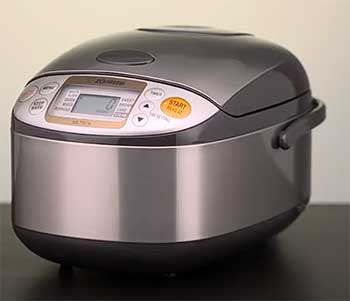Rice is a staple food for over half of the world’s population. Getting perfect rice consistently can be difficult, but electric rice cookers have made the process practically foolproof.
Two of the top brands for electric rice cookers are Zojirushi and Tiger. Their high-end models use advanced cooking technology to make exceptionally fluffy, tasty rice.
Zojirushi uses Micom technology while Tiger relies on Neuro Fuzzy logic. There is an ongoing debate about which approach produces better rice. This article will compare Zojirushi’s Micom with Tiger’s Neuro Fuzzy to see the differences and help you determine which is best for your needs.
A Brief Comparison Table
| Feature | Zojirushi Micom | Tiger Neuro Fuzzy |
| Cooking Technology | Micom (micro computerized fuzzy logic) with advanced AI chip | Neuro Fuzzy artificial intelligence programming |
| Rice Texture | Excellent, specialized for sticky, glossy Asian rice | Excellent, adapts well to all rice varieties |
| Convenience Features | More programs for porridge, sweets, steaming, etc. | Simple rice cooking focused |
| Reliability | Very reliable and durable, 10+ years typical | Reliable and durable, though a bit less than Zojirushi |
| Price | $150 – $300+ | $100 – $250 |
| Best For | Sushi rice, versatility beyond rice cooking | Great rice at a more affordable cost |
Zojirushi Micom Rice Cooker Overview

Zojirushi Corporation is a Japanese manufacturer known for its innovative appliances, especially rice cookers. Their most advanced rice cookers use Micom technology, which stands for “micro computerized fuzzy logic.”
Micom rice cookers have an integrated circuit board with an AI microchip. The microchip can monitor the cooking conditions and make adjustments during the cooking process to produce perfect rice every time.
Here are some key aspects of Zojirushi Micom rice cookers:
- Micom technology continually monitors temperature, heating time, rice consistency and more to adjust cooking duration and heat
- Cooks rice flawlessly from softer sushi rice to chewier brown rice
- Keeps rice warm at optimal serving temperature for extended periods
- Advanced features like reheating cycles and special settings for porridge, sweet rice, etc.
- Higher-end models have stainless steel exteriors and detachable inner pots for easy cleaning
- Range from entry-level 1-2 liters to 10+ cup capacity for large families
Micom rice cookers are on the expensive end, with popular models like the Zojirushi NS-ZCC10 and NS-TSC10 ranging from $150-$300. The sophisticated technology ensures perfect rice but comes at a premium cost.
Tiger Neuro Fuzzy Logic Rice Cooker Overview
Based in Japan, Tiger Corporation is another leading appliance brand best known for its thermal vacuum flasks and rice cookers. Tiger’s high-end rice cookers utilize advanced Neuro Fuzzy logic technology.
Tiger’s Neuro Fuzzy cooking:

- Uses artificial intelligence to think and cook like an experienced rice chef
- Microprocessor analyzes cooking conditions to adapt heat intensity and timing
- Cooks rice properly whether it’s soft, hard, or mixed grain varieties
- Keep warm feature holds rice at ideal serving temperature
- Simple one-push operation makes cooking rice easy
- inner pots, steam vents and more keep rice fresh and delicious
- range from entry-level 3-cup models to 10+ cup cookers for families
Tiger offers a line of JKT and JNP Neuro Fuzzy rice cookers. The mid-range JNP-1800-FL model costs around $130 while higher-end JKT-B10U is priced close to $270. Like Zojirushi, the “brain power” of Tiger’s Neuro Fuzzy technology comes at a premium.
In-depth Comparison of Zojirushi Micom And Tiger Neuro Fuzzy Rice Cookers
Now that we’ve outlined the technologies behind each brand’s high-end rice cookers, let’s compare Micom vs Neuro Fuzzy to see how they stack up.
- Cooking Technology
Both use advanced AI-powered microchips to monitor cooking and adjust as needed for perfect results. However, Zojirushi claims its Micom technology is superior for a few reasons:
- Micom chip has more sensors to detect water temperature, steam volume, cooking stage timing, and other variables
- Automatic adjustments happen more rapidly, like 10 times per second
- Micom is better optimized for Asian rice with precise tweaks during cooking
Tiger’s Neuro Fuzzy also monitors cooking conditions and makes intelligent adjustments. But some users feel Micom responds faster and leads to more consistently flawless rice.
- Rice Texture
The two technologies are designed to produce light, fluffy rice every time. Many users praise both Zojirushi Micom and Tiger Neuro Fuzzy rice cookers for rice that rivals restaurants.
Some feedback indicates Micom may have a slight edge for sushi rice specifically. The precision monitoring helps Micom nail the exact desired sticky texture. But for most rice varieties, the two technologies yield similarly pleasing results.
Also Read: Comparison of Cuckoo And Tiger Rice Cookers.
- Convenience Features
Zojirushi packs more cooking programs and settings into its Micom models. From sushi rice, porridge and sweet rice to cake and stew cooking, Zojirushi aims to be an all-in-one cooker. Micom machines also typically keep rice warmer for longer.
Tiger’s Neuro Fuzzy focuses more specifically on rice cooking. The settings are relatively simple without as many multi-cooking functions. For buyers focused just on everyday rice cooking, Tiger gets the job done without unnecessary bells and whistles.
- Reliability

The general consensus is both Micom and Neuro Fuzzy produce very reliable, long-lasting rice cookers.
They use high-quality construction like stainless steel pots and tri-ply bottom plates for even heating.
Zojirushi tends to edge out Tiger slightly in reported long-term reliability.
But for both, it’s common to see 10+ years of regular use with proper care and maintenance.
Going with either brand is a safe bet for a durable machine.
- Price
As the more feature-packed models with finer-tuned technology, Zojirushi Micom rice cookers come at a higher cost. Expect to spend $150 to $350+ for Micom machines depending on size and capabilities.
Tiger’s Neuro Fuzzy line is also premium-priced, but tends to cost $50-$100 less than comparable Zojirushi models. For shoppers on a budget, Tiger delivers excellent rice cooking for a somewhat lower investment.
Pros and Cons Comparison of Zojirushi Micom And Tiger Neuro Fuzzy Rice Cookers
| Zojirushi Micom | Tiger Neuro Fuzzy | |
| Pros | Very advanced Micom cooking technology fine-tuned for Asian riceIdeal for sushi rice with sticky, glossy textureKeeps rice warm longer, up to 12 hoursMore convenience programs for porridge, sweets, etc.Durable and long-lasting with quality construction | AI-powered intelligent cooking adapts to all rice typesSimple 1-push operation for basic rice cookingExcellent texture and flavor rivaling restaurantsMore budget-friendly price than Zojirushi |
| Cons | Upper-end models are expensive $200-$300+Complex programming can be overkill for casual needsBulky 10+ cup size models | Fewer convenience cooking functionsPricier than basic rice cookersWarm mode may not maintain as long as Zojirushi |
Also Read: Is Hamilton Beach Better Than Crock-Pot Slow Cooker?
Frequently Asked Questions (FAQ)
The main difference is the technology inside the microchip. Zojirushi Micom relies on advanced micro computerized fuzzy logic. Tiger uses artificial intelligence neuro fuzzy programming. Both monitor cooking and make intelligent adjustments. Micom focuses on precision fine-tuning for Asian rice textures. Neuro fuzzy aims for adaptable cooking of all rice varieties.
Micom stands for “micro computerized fuzzy logic”. It refers to the AI-powered integrated circuit board inside Zojirushi rice cookers. Micom continuously analyzes temperature, time, steam, and other variables and makes precise heating and timing changes for perfect rice cooking, especially sushi rice.
For most home cooks, Zojirushi and Tiger both produce excellent rice. Zojirushi Micom technology is more sophisticated and specialized for Asian rice. But it comes at a higher price. Tiger Neuro Fuzzy models are also very advanced and cost somewhat less. For top-notch rice, you can’t go wrong with either brand. Zojirushi may be better for those who eat mainly sushi rice.
Three main factors account for Zojirushi’s higher prices:
1. Advanced Micom cooking technology – The microcomputer and fuzzy logic AI programming optimizes cooking.
2. More feature variety – Zojirushi cookers have more settings and convenience programs.
3. Quality materials – Zojirushi uses high-end stainless steel and durable construction.
The sophisticated Micom chip fine-tuned for Asian rice textures delivers exceptional results. But the advanced tech and extra features come at a premium price. For buyers focused on delicious everyday rice, Tiger is also a great choice at a more affordable cost.
Wrapping Up
Zojirushi Micom and Tiger Neuro Fuzzy take rice cooking to the next level. Their intelligent cooking technology produces flawless rice with minimal effort. Choosing between the two brands depends on your budget and specific needs.
For cooks who regularly make Asian rice varieties like sushi rice, Zojirushi’s precision Micom technology is likely the better choice despite the higher price tag. If you want a feature-packed cooker that goes beyond just rice, Zojirushi is also the way to go.
For easy delicious rice at a more affordable cost, Tiger’s Neuro Fuzzy models are an excellent option. The simpler interface focuses on rice cooking without too many extra frills.
Ultimately both Zojirushi and Tiger make incredibly advanced rice cookers. Paying more for Micom technology makes sense for some buyers given the specialized sushi rice results and extra versatility.
But Neuro Fuzzy also produces restaurant-quality rice for a lower investment. Choose the brand that best fits your budget, cooking needs and how often you plan to use advanced programs vs just making daily rice. Either way your rice will turn out much tastier than stovetop methods!
